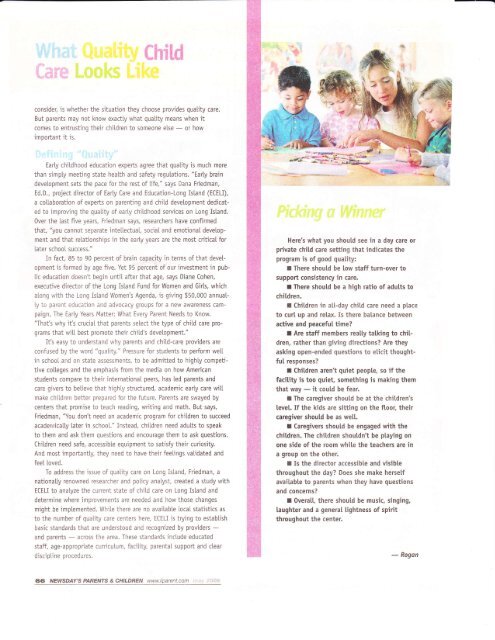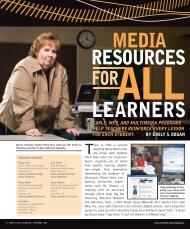What Quality Childcare Looks Like - Emily Rogan
What Quality Childcare Looks Like - Emily Rogan
What Quality Childcare Looks Like - Emily Rogan
Create successful ePaper yourself
Turn your PDF publications into a flip-book with our unique Google optimized e-Paper software.
,,,li.i f 1..;,.<br />
fltu{&d<br />
consider, is whether the situation they choose provides quality care.<br />
But parents may not know exactly what quatity means when it<br />
comes to entrusting their children to someonetse - or how<br />
'imoorlant it is.<br />
Early chil.dhood education experts agree that quatity is much more<br />
than simpl.y meeting state health and safety regulations. "Early brain<br />
development sets the pace for the rest of [ife," says Dana Friedman,<br />
Ed.D.. project director of Early Care and Education-Long Istand (ECEU),<br />
a collaboration of experts on parenting and chitd devetopment dedicated<br />
to improving the qual.ity of earty chitdhood services on Long Istand.<br />
Over the last five years, Friedman says, researchers have confirmed<br />
that. "you cannot separate intellectual. social and emotional devetopment<br />
and that relationships in the early years are the most critical for<br />
later schooI success."<br />
In fact, 85 to 90 percent of brain capacity in terms of that deve[-<br />
opment is formed by age five. Yet 95 percent of our investment in public<br />
education doesn't begin untit after that age. says Diane Cohen.<br />
executive director of the Long Istand Fund for Women and Girts, which<br />
atong with the Long Istand Women's Agenda. is giving $50,000 annuat-<br />
[y to parent education and advocacy groups for a new awareness campaign.<br />
The Earty Years Matter: <strong>What</strong> Every Parent Needs to Know.<br />
"Thafs why ifs crucia[ that parents selecthe type of chitd care programs<br />
that witl best promote their chi[d's devetopment."<br />
Ifs easy to understand why parents and chitd-care providers are<br />
confused by the word "quatity." Pressure for students to perform we[[<br />
in schooL and on state assessments, to be admitted to highly competitive<br />
cotleges and the emphasis from the media on how American<br />
students compare to their internationaI peers, has led parents and<br />
care givers to beUeve that highty structured, academic earty care wi[[<br />
make chjLdren better prepared for the future. Parents are swayed by<br />
centers that promise to teach reading, writing and math. But says,<br />
Friedman, 'You don't need an academic program for children to succeed<br />
acaderirically later in schoot." Instead, chitdren need adutts to speak<br />
to them and ask them questions and encourage them to ask questions.<br />
Childre need safe, accessiblequipment to satisfy their curiosity.<br />
And most importantly, they need to have their feelings validated and<br />
feel loved.<br />
To address the issue of quatity care on Long Island, Friedman, a<br />
nationatty renowned researcher and poticy analyst, created a study with<br />
ECELI to anatyze the current state of chitd care on Long Island and<br />
determine where improvements are needed and how those changes<br />
might be imptemented. While there are no avaitabte [oca|' statistjcs as<br />
to the number of quatity care centers here, ECELI is trying to establish<br />
basic standards that are understood and recognized by providers -<br />
and parents - across the area. These standards include educated<br />
staff, age-appropriate curricutum, facitity, parentat support and ctear<br />
discio[ine orocedures.<br />
Here's what you should see in a day care or<br />
private chitd care setting that indicates the<br />
program is of good quatity:<br />
I There should be low staff turn-over to<br />
support consistency in care.<br />
I There should be a high ratio of adutts to<br />
chitdren.<br />
r Children in atl-day child care need a ptace<br />
to curt up and relax. Is there batance between<br />
active and peaceful time<br />
I Are staff members really tatking to chiLdren,<br />
rather than giving directions Are they<br />
asking open-ended questions to eticit thoughtfuI<br />
responses<br />
I Chitdren aren't quiet peopte, so if the<br />
facitity is too quiet, something is making them<br />
that way - it couLd be fear.<br />
I The caregiver should be at the chitdren's<br />
tevet. If the kids are sitting on the ftoor, their<br />
caregiver should be as welt.<br />
I Caregivers shoutd be engaged with the<br />
chitdren. The chitdren shouldn't be ptaying on<br />
one side of the room while the teachers are in<br />
a group on the other.<br />
I Is the director accessibte and visible<br />
throughout the day Doe she make hersetf<br />
avaitable to parents when they have questions<br />
and concerns<br />
I Overa[[, there should be music, singing,<br />
laughter and a general lightness of spirit<br />
throughout the center.<br />
- <strong>Rogan</strong><br />
66 ,VEWSDAy'S PARE TTS & CH,LDREN www.liDarent.com




